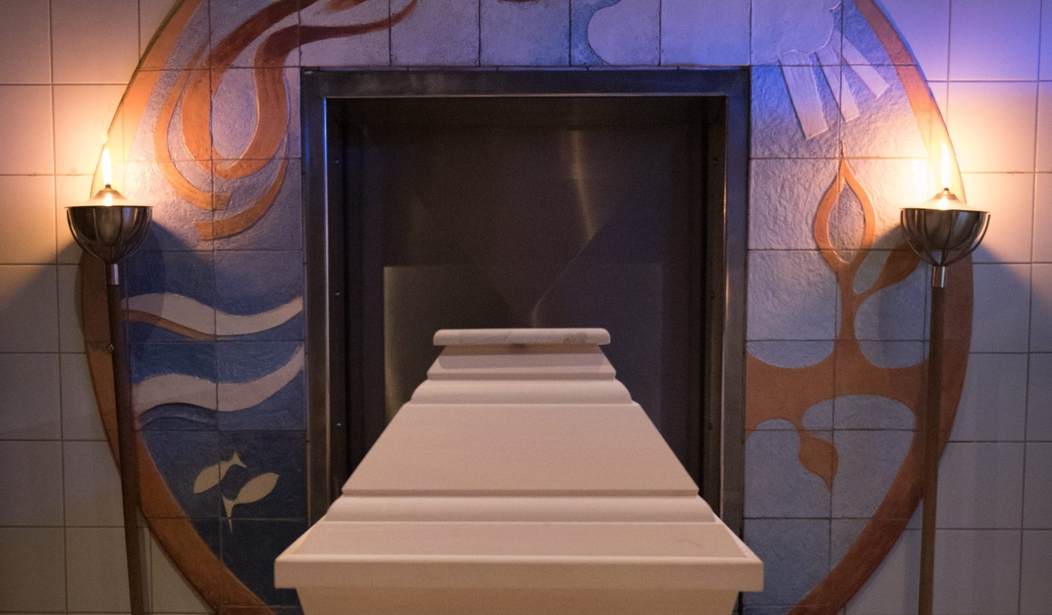When an aunt on my mother’s side of the family died last year, I expected to see a traditional Catholic funeral — meaning a coffin, and an officiating priest circling it with a censor. Instead, the mass began with immediate family members processing up the aisle carrying a small wooden box. I could barely contain my disappointment: Aunt Jackie had been cremated! I grew up Catholic; cremation was always forbidden. Local Catholic bookstores and the vestibules of most parishes offered booklets explaining why.
I did my best to concentrate on Aunt Jackie, listening to the readings and to the tender memories related by her children and others. “The important thing is her spirit,” I told myself. “This is not about Aunt Jackie’s body.” But try as I did, something seemed to be missing. With a body in a casket, there’s a feeling of closure. With a box of ashes, the funeral becomes a memorial service. It was as if Aunt Jackie had died long ago.
The modern Catholic Church began permitting cremation in 1964, after the Second Vatican Council, but with stipulations: Catholics could not scatter the ashes of a loved one just anywhere, but must place them in a consecrated crypt or sacred ground. Nor could they keep the ashes of Uncle Ted or Aunt Martha in an urn on the living room mantelpiece. These restrictions rule out untoward party behavior years down the road, after the sorrowful aspects of the death have faded, when relatives might be tempted to say, “Let’s give Uncle Ted a high five” — code for “Let’s open the urn and give the ashes a little stir” — after a white wine toast, of course.
Cremation is all the rage in today’s culture. It was the rage in the Indus Valley too, starting around 1900 BC. In ancient Greece, soldiers who died on the battlefield were burned, their ashes sent home; it was an economical method of dealing with death. Yet ground burial was common in ancient Rome, at least until Emperor Sulla was cremated in 78 BC. Then cremation became a status symbol among wealthy Romans.
The ancients opted for cremation because they feared that thieves would steal their bodies, or because they saw burning as a way to prevent the soul from wandering after death. Cremation remains a no-no in Eastern Christianity. Religious Jews proscribe it because they anticipate mass resurrection of the dead.
I’m squeamish about cremation for several reasons. In Philadelphia, when a person is cremated, their ashes are often scattered in various places — Rittenhouse Square, Valley Green, Penn Treaty Park, other local parks, or even onto a remote section of I-95. When they die, cremation fans want their ashes placed in their favorite places — Disney World will do — rather than somewhere old-fashioned, like a cemetery, where relatives and friends can visit, pray, and place flowers. “I want my ashes taken on a small plane and dispersed over the Snake River in Idaho, but only after a quarter of the ashes have been scattered in and around the Great Salt Lake,” someone might say, unmindful of the amount of work this involves.
Making their case, cremation advocates cite the convenience, low cost, and hygienic nature of burning. “Cremation is ecological,” they say — incorrectly. Cremation releases hundreds of pounds of carbon dioxide into the atmosphere. The amount of fuel required to burn a body — roughly four to five hours’ worth — could heat a house for a week. Other unsavory aspects include the explosion of the human head in the crematorium — it literally pops, like Fourth of July fireworks or a tire going out on the highway. Crematorium workers — shoving the bodies in and out of the ovens with factory-like precision — become complacent and almost always mix the ashes of the dead, meaning that the charming urn or mahogany box produced at the end contains more than just Aunt Sadie’s ashes.
I’ve often heard pro-cremation folks cite their fear of being buried alive and waking up in a coffin, six feet under. “I don’t want to be scratching the lid of the coffin,” one man told me, moving both hands like a cat at a scratching post.
“The days of Edgar Allan Poe are over,” I said. “You’d rather have your head explode in a gas oven?”
“When you’re dead, you’re dead.”
“Well, do you know that bones are 60 percent inorganic, non-combustible matter, and that’s why unburned bone has to be pulverized into tiny granules by a separate machine? And did you know that UPS and FedEx will not transport the ashes of cremated bodies because of package leaks?”
When Jessica Mitford published The American Way of Death in 1963, she shined a needed light on funeral industry abuses. Funerals in the Sixties became tremendously expensive thanks to the business practices of funeral directors, who preyed on family and friends of the deceased to spend more and more money to show their love for “the dearly departed.” One such innovation was the invention of “grief counselors,” or funeral home employees who’d sit and hold your hand, which used to be the job of family members or clergy. Surely the staggering (and often exploitative) costs of traditional funerals have played a major role in the popularity of cremation.
Yet some people, at least, are having second thoughts, in part out of realization that cremation is not as ecologically sound as advertised. Home kits explain how the bodies of loved ones can be cleaned and dressed at home prior to a “green burial,” involving a cheap pine casket and no embalming. Not to miss a trick, the cremation industry has developed a process called “resomation,” which does not release carbon dioxide into the air but instead pulverizes the corpse into liquid. Sometimes called “toilet burial,” this neo-pagan practice involves placing human remains, water, and potassium hydroxide into a steel tank and heating it until everything melts. A portion of the leftovers can be placed in a funeral urn, but the balance is thrown into the sewage system.
Give me Edgar Allan Poe any day.









Join the conversation as a VIP Member